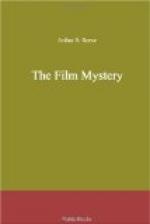“Well, I imagine a small roll of very dry film was put in to occupy a part of the space. Film is exceedingly inflammable, especially when old and brittle. In composition it is practically guncotton and so a high explosive. In this recent war, I remember, the Germans drained the neutral countries of film subjects until we woke up to what they were doing, while in this country scrap film commanded an amazing price and went directly into the manufacture of explosives. Then I figure that a quantity of wet phosphorus was added, to fill the can, and that then the can was taped. The tape, of course, is not moisture proof entirely. With the dampness from within it would soften, might possibly fall off. In a relatively short time the phosphorus would dry and burn. Immediately the film in the can would ignite. As happened, it blew up, a minor explosion, but enough to scatter phosphorus everywhere. That, in the fume-laden air of the vault— there are always fumes in spite of the best ventilation system made—caused the first big blast and started all the damage.”
Mackay had rejoined us in time to hear the explanation. “Ingenious,” he murmured. “As ingenious as the methods used to murder the girl and her director.”
Breathless, Wagnalls returned with the collodion. We watched curiously as Kennedy poured it over the charred remains of the second order on the spindle. It seemed almost inconceivable that the remnants of the charred paper would even support the weight of the liquid, yet Kennedy used it with care, and slowly the collodion hardened before us, creating a tough transparent coating which held the tiny fibers of the slip together. At the same time the action of the collodion made the letters on the order faintly visible and readable.
“A little-known bank trick!” Kennedy told us.
Then he held the slip up to the light and the words were plain. Wagnalls had been correct. The order from Manton was unmistakable. The can was to be kept in the negative vault for a week without being opened, until a certain party unnamed was to come to watch the development of the film.
The promoter wet his lips, uneasily. “I—I never wrote that! It— it’s my writing, all right, and my signature, but it’s a forgery!”
XXIX
MICROSCOPIC EVIDENCE
Kennedy made some efforts to preserve the forged order which he had restored with the collodion, but I could see that he placed no great importance upon its possession. Gradually the yard of the studio had cleared of the employees, who had returned to their various tasks. Under the direction of one stout individual who seemed to possess authority the fire apparatus had been replaced in a portable steel garage arranged for the purpose in a farther corner, and now several men were engaged in cleaning up the dirt and litter caused in the excitement.
Except in the basement there were few signs of the blaze. Manton accompanied the fire chief to his car, then hurried up into the building without further notice of us. Mackay went to McGroarty’s machine to claim the traveling bag containing our evidence. Kennedy and I started for the dressing rooms.




